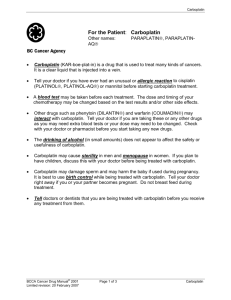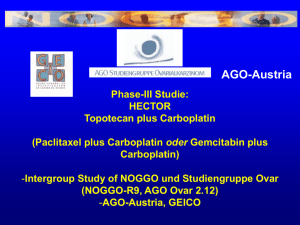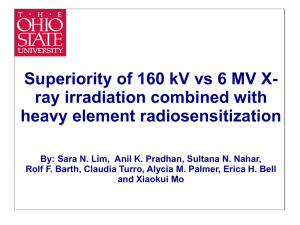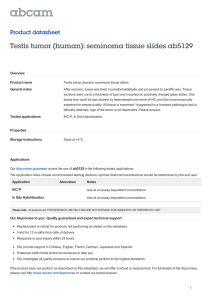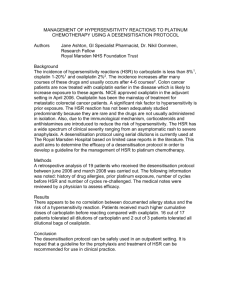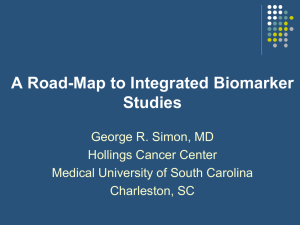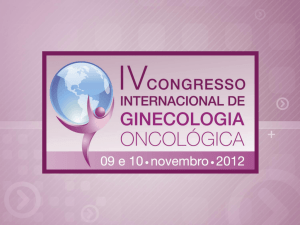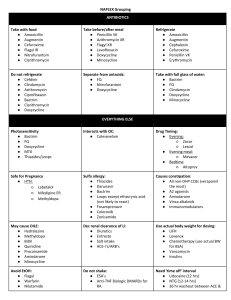Carboplatin vs Radiotherapy for Seminoma: A Clinical Oncology Trial
advertisement
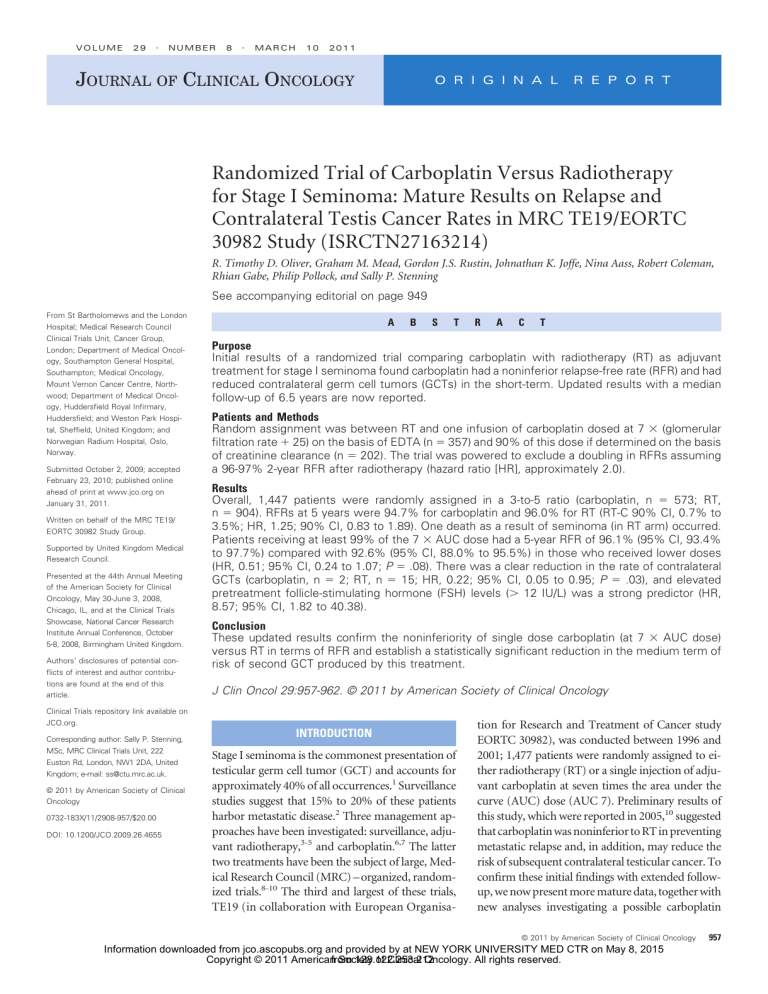
VOLUME 29 䡠 NUMBER 8 䡠 MARCH 10 2011 JOURNAL OF CLINICAL ONCOLOGY O R I G I N A L R E P O R T Randomized Trial of Carboplatin Versus Radiotherapy for Stage I Seminoma: Mature Results on Relapse and Contralateral Testis Cancer Rates in MRC TE19/EORTC 30982 Study (ISRCTN27163214) R. Timothy D. Oliver, Graham M. Mead, Gordon J.S. Rustin, Johnathan K. Joffe, Nina Aass, Robert Coleman, Rhian Gabe, Philip Pollock, and Sally P. Stenning See accompanying editorial on page 949 From St Bartholomews and the London Hospital; Medical Research Council Clinical Trials Unit, Cancer Group, London; Department of Medical Oncology, Southampton General Hospital, Southampton; Medical Oncology, Mount Vernon Cancer Centre, Northwood; Department of Medical Oncology, Huddersfield Royal Infirmary, Huddersfield; and Weston Park Hospital, Sheffield, United Kingdom; and Norwegian Radium Hospital, Oslo, Norway. Submitted October 2, 2009; accepted February 23, 2010; published online ahead of print at www.jco.org on January 31, 2011. Written on behalf of the MRC TE19/ EORTC 30982 Study Group. Supported by United Kingdom Medical Research Council. Presented at the 44th Annual Meeting of the American Society for Clinical Oncology, May 30-June 3, 2008, Chicago, IL, and at the Clinical Trials Showcase, National Cancer Research Institute Annual Conference, October 5-8, 2008, Birmingham United Kingdom. Authors’ disclosures of potential conflicts of interest and author contributions are found at the end of this article. A B S T © 2011 by American Society of Clinical Oncology 0732-183X/11/2908-957/$20.00 DOI: 10.1200/JCO.2009.26.4655 A C T Purpose Initial results of a randomized trial comparing carboplatin with radiotherapy (RT) as adjuvant treatment for stage I seminoma found carboplatin had a noninferior relapse-free rate (RFR) and had reduced contralateral germ cell tumors (GCTs) in the short-term. Updated results with a median follow-up of 6.5 years are now reported. Patients and Methods Random assignment was between RT and one infusion of carboplatin dosed at 7 ⫻ (glomerular filtration rate ⫹ 25) on the basis of EDTA (n ⫽ 357) and 90% of this dose if determined on the basis of creatinine clearance (n ⫽ 202). The trial was powered to exclude a doubling in RFRs assuming a 96-97% 2-year RFR after radiotherapy (hazard ratio [HR], approximately 2.0). Results Overall, 1,447 patients were randomly assigned in a 3-to-5 ratio (carboplatin, n ⫽ 573; RT, n ⫽ 904). RFRs at 5 years were 94.7% for carboplatin and 96.0% for RT (RT-C 90% CI, 0.7% to 3.5%; HR, 1.25; 90% CI, 0.83 to 1.89). One death as a result of seminoma (in RT arm) occurred. Patients receiving at least 99% of the 7 ⫻ AUC dose had a 5-year RFR of 96.1% (95% CI, 93.4% to 97.7%) compared with 92.6% (95% CI, 88.0% to 95.5%) in those who received lower doses (HR, 0.51; 95% CI, 0.24 to 1.07; P ⫽ .08). There was a clear reduction in the rate of contralateral GCTs (carboplatin, n ⫽ 2; RT, n ⫽ 15; HR, 0.22; 95% CI, 0.05 to 0.95; P ⫽ .03), and elevated pretreatment follicle-stimulating hormone (FSH) levels (⬎ 12 IU/L) was a strong predictor (HR, 8.57; 95% CI, 1.82 to 40.38). Conclusion These updated results confirm the noninferiority of single dose carboplatin (at 7 ⫻ AUC dose) versus RT in terms of RFR and establish a statistically significant reduction in the medium term of risk of second GCT produced by this treatment. J Clin Oncol 29:957-962. © 2011 by American Society of Clinical Oncology Clinical Trials repository link available on JCO.org. Corresponding author: Sally P. Stenning, MSc, MRC Clinical Trials Unit, 222 Euston Rd, London, NW1 2DA, United Kingdom; e-mail: ss@ctu.mrc.ac.uk. R INTRODUCTION Stage I seminoma is the commonest presentation of testicular germ cell tumor (GCT) and accounts for approximately 40% of all occurrences.1 Surveillance studies suggest that 15% to 20% of these patients harbor metastatic disease.2 Three management approaches have been investigated: surveillance, adjuvant radiotherapy,3-5 and carboplatin.6,7 The latter two treatments have been the subject of large, Medical Research Council (MRC) – organized, randomized trials.8-10 The third and largest of these trials, TE19 (in collaboration with European Organisa- tion for Research and Treatment of Cancer study EORTC 30982), was conducted between 1996 and 2001; 1,477 patients were randomly assigned to either radiotherapy (RT) or a single injection of adjuvant carboplatin at seven times the area under the curve (AUC) dose (AUC 7). Preliminary results of this study, which were reported in 2005,10 suggested that carboplatin was noninferior to RT in preventing metastatic relapse and, in addition, may reduce the risk of subsequent contralateral testicular cancer. To confirm these initial findings with extended followup, we now present more mature data, together with new analyses investigating a possible carboplatin © 2011 by American Society of Clinical Oncology Information downloaded from jco.ascopubs.org and provided by at NEW YORK UNIVERSITY MED CTR on May 8, 2015 Copyright © 2011 Americanfrom Society of Clinical Oncology. All rights reserved. 128.122.253.212 957 Oliver et al dose response effect on relapse rates and risk factors for contralateral cancer. PATIENTS AND METHODS Consenting patients with stage I, histologically confirmed, seminomatous GCT (classical or anaplastic) and normal markers were eligible, as previously described. The primary random assignment of the study was between irradiation (optional subrandom assignment with respect to dose) and one infusion of carboplatin with dose adjusted by renal function to provide seven times the AUC estimate of glomerular filtration rate (GFR). Random assignment was effected by minimization, and stratification was by center, previous inguino/ pelvic/scrotal surgery, and intended RT schedule (ie, randomly assigned or elected). Treatment Schedules Carboplatin. Using 7 ⫻ (GFR ⫹ 25), the carboplatin dose in milligrams was given as a single, intravenous (IV) dose.11 EDTA or a comparable isotopemeasurement technique was the recommended method of measuring GFR. When this method was unavailable, a urinary 24-hour creatinine clearance (but not a calculated GFR by using, for example, the Cockcroft formula) was also permitted. In the latter case, the protocol recommended that the dose given should be 10% lower than if the dose had been calculated on the basis of EDTA clearance. This has allowed exploratory analysis of the impact of carboplatin dose on outcome. RT. The RT dose was determined either by an optional random assignment between 30 Gy in 15 fractions and 20 Gy in 10 fractions as part of the TE18 trial9 or, for those patients who did not enter this additional random assignment, by physician choice. In this latter group, schedules delivering a total dose of 20 Gy, 30 Gy, or an intermediate dose were permissible after discussion with the principal investigators. The recommended RT field was a para-aortic (PA) strip; however a dog leg (DL) field was recommended for patients with previous inguinal surgery, as in our previous trials. Gonadal Function Assays Serial gonadal function was assessed by measurement of folliclestimulating hormone (FSH), luteinizing hormone (LH), and testosterone levels. Levels were obtained at pretreatment and at 12 and 24 months after treatment. Follow-Up Investigations and Management of Relapse Clinical and tumor marker assessments took place every 3 months in year 1; every 4 months in year 2; every 6 months in year 3; annually thereafter until year 10. Chest x-rays were done at 6, 12, 20, 30, and 36 months, and computed tomography (CT) scans of chest, abdomen, and pelvis were done at 12, 24, and 36 months. On relapse, standard chemotherapy regimens for metastatic seminoma were recommended, but those patients who experienced relapses localized outside previously irradiated areas could be managed with RT at the treating clinician’s discretion. The primary outcome measure was relapse-free rate; death as a result of any cause and second cancer incidence were also recorded, as was morbidity, which was assessed via patient diary cards. The latter was reported in the initial publication and is not repeated here. Statistical Considerations The aim of the trial was to demonstrate the noninferiority of carboplatin in comparison with irradiation, irrespective of dose. It is now known that 20 Gy is equivalent in efficacy to 30 Gy.9 As this had not been demonstrated at the time the trial was initiated, the trial included an optional random assignment between these doses. To optimize the overall power of the trial for both primary (RT v carboplatin) and secondary comparisons (30 Gy v 20 Gy v carboplatin) patients were randomly assigned between RT and carboplatin in a five-to-three ratio; hence, 30 Gy RT, 20 Gy RT, and carboplatin, when applicable, were randomly assigned in a ratio of 2.5 to 2.5 to 3, respectively. Assuming a 2-year relapse-free rate after RT of 96% to 97%, the trial was powered to exclude a doubling of the relapse rate at 2 years with 90% power at a one-sided significance level of 5%. This corresponds to a hazard ratio (HR) of Patients randomly assigned (N = 1,477) Allocated to carboplatin Mean (SD) age, years Raised HCG pre-orchidectomy Previous ipsilateral operation Median (IQR) days from orchidectomy to treatment (n = 573) (n = 38.2; 9.0) (n = 88; 15%) (n = 56; 10%) (n = 45; 33-56%) Allocated to radiotherapy Mean (SD) age, years Raised HCG pre-orchidectomy Previous ipsilateral operation Median (IQR) days from orchidectomy to treatment (n = 904) (n = 38.5; 9.8) (n = 121; 13%) (n = 86; 10%) (n = 57; 46-70%) Randomly assigned with respect to radiotherapy dose? Carboplatin received Not received (n = 561) Analyzed (n = 573) Excluded from analysis ITT analysis PPA 958 (n = 12) (n = 0) (n = 12) © 2011 by American Society of Clinical Oncology YES (n = 583) NO (n = 321) Allocated 20 Gy (n = 289) Allocated 30 Gy (n = 294) Received center’s standard RT schedule Radiotherapy received Not received Analyzed Excluded from analysis ITT analysis PPA Fig 1. CONSORT diagram. SD, standard deviation; HCG, human chorionic gonadotrophin; IQR, interquartile range; RT, radiotherapy; ITT, intent-to-treat; PPA, per-protocol analysis. (n = 887) (n = 17) (n = 904) (n = 0) (n = 17) JOURNAL OF CLINICAL ONCOLOGY Information downloaded from jco.ascopubs.org and provided by at NEW YORK UNIVERSITY MED CTR on May 8, 2015 Copyright © 2011 Americanfrom Society of Clinical Oncology. All rights reserved. 128.122.253.212 Carboplatin or Radiotherapy for Stage I Seminoma: Mature Results Analysis As the clinical equivalence of 30 Gy and 20 Gy has now been demonstrated,9 this analysis has focused on the primary comparison of RT versus carboplatin. RFRs were calculated by using the Kaplan-Meier method and were compared by using the log-rank test; HRs and 90% CIs were computed by using Cox proportional hazard regression model (HR ⬎ 1 favors RT). CIs for the difference in relapse-free rates at 2 and 5 years were calculated by direct comparison of proportions and by application of the HR and its 90% CI to the relapse-free rate in the control arm. Both intent-to-treat (ITT) analyses and per-protocol analyses (PPA) were carried out, as poor compliance can bias toward equivalence in an ITT analysis. PPA included all patients known to have started their allocated treatment (CONSORT diagram, Fig 1). 1.0 Relapse-Free Survival (proportion) approximately 2.0; thus, for this updated analysis to demonstrate noninferiority with respect to relapse rates in the longer term, the upper confidence limit of a two-sided 90% CI for the HR must be less than 2.0. RESULTS Table 1. Summary of Events Treatment Arm Carboplatin (n ⫽ 573) Radiotherapy (n ⫽ 904) Event No. % No. % Total relapse New primary cancers GCT Other Total deaths Death as a result of seminoma Death as a result of other cause 29 7 2 5 6 0 6 5.1 1.2 37 25 15 10 10 1 9 4.1 2.8 www.jco.org C RT 0.8 0.7 0.6 0.5 0.4 0.3 0.2 0.1 0 Overall, 1,477 patients were recruited to the trial between 1996 and 2001; 573 were randomly assigned to carboplatin, and 904 were randomly assigned to RT. Eighty-seven percent of the patients had PAfield radiotherapy. Ten patients did not receive their allocated treatment because of revised stage (carboplatin, n ⫽ 2; RT, n ⫽ 4) or histology (RT, n ⫽ 4) before starting treatment; an additional 17 patients (carboplatin, n ⫽ 9; RT, n ⫽ 8) withdrew and requested alternative (or no) treatment; and treatment data are missing for one patient in each group. These patients were excluded from the PPA. Follow-up data for this analysis were obtained directly from the participating sites during 2007. All events up to the date of last clinic visit were included to ensure reliable data on recurrence. Protocolspecified follow-up was for a maximum of 10 years. The median follow-up is now approximately 6.5 years in both treatment groups (interquartile range, 5.2 to 8 years). The number of patients who have a minimum of 5 years documented follow-up has increased since our last report from 333 to 1,148 (79%), whereas 615 patients (40%) have a minimum follow-up of 7 years (which has increased from 18 patients). The updated results confirm the noninferiority of single-dose carboplatin (Table 1; Fig 2) with only one additional relapse reported (in the R arm at 61 months). The RFRs were 97.3% (C) versus 96.5% (RT) at 2 years and 94.7% for the carboplatin arm versus 96.0% for the RT arm respectively at 5 years (ITT analysis: HR, 1.25; 90% CI, 0.83 to 1.89; P ⫽ .37; PPA: HR, 1.27; 90% CI, 0.83 to 1.92; P ⫽ .36). The 90% CI for the absolute difference excludes rates above 3% at 2 years and Abbreviation: GCT, germ cell tumor. 0.9 1.0 1.1 12 24 36 48 60 72 84 96 108 120 Time Since Random Assignment (months) No. at risk C 573 551 533 495 464 407 338 219 116 49 8 RT 904 879 838 800 762 690 529 365 195 85 22 Fig 2. Relapse-free rates (RFRs) by allocated treatment. Intent-to-treat (ITT) analysis (hazard ratio [HR] ⬎ 1 favors radiotherapy [RT]): HR, 1.25; 90% CI, 0.83 to 1.89; P ⫽ .37. Per-protocol analysis (PPA): HR, 1.27; 90% CI, 0.83 to 1.92; P ⫽ .36. RFR at 5 years: radiotherapy, 96.0% (95% CI, 94.5% to 97.1%); carboplatin (C), 94.7% (95% CI, 92.5% to 96.3%). RFR absolute difference at 5 years: RT-to-C difference, 1.34%; 90% CI, ⫺0.7% to 3.5%. above 3.5% at 5 years by both methods. Ten patients have died in the RT arm: one as a result of seminoma, three as a result of other (ie, non-GCT) cancers, and six as a result of other noncancer causes. Six patients have died in the carboplatin arm: none as a result of seminoma; two as a result of other (ie, non-GCT) cancers; and four as a result of other noncancer causes. Contralateral GCTs have been reported in two patients in the carboplatin arm and in 15 in the RT arm; the contralateral GCT–free rates at 5 years are 99.8% and 98.8%, respectively (Fig 3A), which results in a relative reduction in risk of nearly 80% (HR, 0.22; 95% CI, 0.05 to 0.95; P ⫽ .03). A strong predictor of contralateral GCT was pretreatment FSH. This was recorded in 1,008 patients, of whom 31% had raised levels (ie, ⬎ 12 IU/L). These patients showed an 8.6-fold increase in the rate of contralateral cancer compared with those who had a normal (ie, ⱕ 12 IU/L) FSH (HR, 8.57; 95% CI, 1.82 to 40.4; P ⫽ .001; Fig 3B). Exploratory Analyses Of 559 patients in the carboplatin arm for whom the method of GFR assessment was known, 347 used EDTA or comparable isotopic techniques and had a mean GFR of 128 mL/min, whereas 212 used urinary creatinine clearance and had a mean GFR of 125 mL/min. The patientsintheformergroupwereplannedtoreceiveadoseof7⫻(GFR⫹ 25);thoseinthelattergroupwereplannedtoreceive90%ofthisdose.This gave an opportunity for an exploratory analysis of RFRs according to the proportion of the AUC 7 dose received (Fig 4). The 5-year RFRs were 92.6% (95% CI, 88.0% to 95.5%) and 96.1% (95% CI, 93.4 to 97.7%), respectively, (HR, 0.51; 95% CI, 0.24 to 1.07; P ⫽ .08) whether the dose received was less than AUC 7 or at least AUC 7; after adjustment for GFR method, the results were similar (HR, 0.48; 95% CI, 0.16 to 1.42; P ⫽ .19). Serial FSH measurements (at pretreatment and also at 12 ⫾ 2 months and 24 ⫾ 2 months) were available for 170 patients receiving carboplatin and for 243 patients receiving RT, of whom the majority (n ⫽ © 2011 by American Society of Clinical Oncology Information downloaded from jco.ascopubs.org and provided by at NEW YORK UNIVERSITY MED CTR on May 8, 2015 Copyright © 2011 Americanfrom Society of Clinical Oncology. All rights reserved. 128.122.253.212 959 Oliver et al 1.0 1.00 0.9 0.99 0.98 Relapse-Free Rate Contralateral GCT-Free Survival (proportion) A C RT 0.97 0.96 0.95 0.94 0.5 0.4 0.3 0.2 0.1 0.91 0 12 0.90 12 24 36 48 60 72 84 96 108 120 No. at risk C 573 557 548 532 493 447 369 252 135 58 9 RT 904 889 867 828 783 723 556 383 208 89 21 Contralateral GCT-Free Survival (proportion) < 7AUC ≥ 7AUC 0.6 0.92 Time Since Random Assignment (months) 1.00 0.99 0.98 ≤ 12 U/l > 12 U/l 0.97 0.96 0.95 0.94 0.93 0.92 0.91 0.90 0 12 24 36 48 60 72 84 96 108 120 Time Since Random Assignment (months) No. at risk ≤ 12 U/l 691 667 661 637 603 539 418 276 130 52 11 > 12 U/l 315 310 304 288 273 251 200 135 75 33 7 Fig 3. (A) Contralateral germ cell tumor (GCT) rates by allocated treatment (truncated y-axis). Second GCT-free rate at 5 years: radiotherapy (RT), 98.8% (95% CI, 97.8% to 99.4%); carboplatin (C), 99.8% (95% CI, 98.6% to 99.9%). Hazard ratio (HR), 0.22; 95% CI, 0.05 to 0.95; P ⫽ .03. (B) Contralateral GCT rate by pretreatment follicle-stimulating hormone (FSH; truncated y-axis): ⱕ 12 IU/L v ⬎ 12 IU/L. Pretreatment FSH: normal (ⱕ 12 IU/L), 99.8% (95% CI, 98.9% to 99.9%); increased (⬎ 12 IU/L), 98.2% (95% CI, 96.0% to 99.3%); HR, 8.57; 95% CI, 1.82 to 40.4; log-rank P ⫽ .001. 185) received RT to the PA strip without scrotal shielding. Median FSH levelsatthesetimepointswere9.4,10.0,and9.6IU/Lforpatientsreceiving carboplatin and were 9.9, 11.0, and 9.9 IU/L for the patients receiving PA RT. Within-patient changes from baseline were compared across treatment groups and showed no clear evidence of a differential treatment impact (t test P ⫽ .15 and P ⫽ .17 at 12 and 24 months, respectively). DISCUSSION This article provides mature data for patients and their physicians on the relative long-term efficacy of a single infusion of carboplatin as adju960 0.7 0.93 0 B 0.8 © 2011 by American Society of Clinical Oncology No. at risk: < 7AUC ≥ 7AUC 24 36 48 60 72 84 96 108 120 Time Since Random Assignment (months) 212 346 203 339 192 333 178 308 163 294 137 266 110 225 67 150 35 80 15 34 5 3 Fig 4. Relapse-free rate (RFRs) by received carboplatin dose less than seven times area under the curve (AUC) compared with seven or more times the AUC. RFR at 5 years: carboplatin dose less than seven times AUC, 92.6% (95% CI, 88.0% to 95.5%; seven or more times AUC, 96.1%; 95% CI, 93.4% to 97.7%; hazard ratio [HR], 0.51; 95% CI, 0.24 to 1.07; P ⫽ .08 (unadjusted for glomerular filtration rate [GFR] method); HR, 0.48; 95% CI, 0.16 to 1.42; P ⫽ .19 (adjusted for GFR method). HR less than 1 favors higher dose. vant treatment for stage I seminoma. The initial studies of one and two courses of adjuvant carboplatin that motivated this work, including the first to use a single course at AUC 7,6 are also now mature and provide additional evidence of the long-term safety and efficacy of this approach. The management of this condition should be a matter of informed choice. The anticipated relapse rate in patients managed expectantly is in the range of 15% to 20%,2,12 and primary cure rates for the three currently available management options (ie, surveillance, adjuvant RT, and carboplatin) approach 100% in all modern series. As a result of this large, randomized trial of RT and carboplatin, of previous radiation-field and dose trials,8,9 and of retrospective case series of surveillance,2 there are now adequate data on efficacy, short-term morbidity, contralateral cancer, and necessary follow-up arrangements to inform this decision. Adjuvant carboplatin as described in our previous paper is associated with minimal short-term toxicity10 and has no significant effect on fertility, as judged by serial FSH levels.10,13 Relapse rates are reduced by between two thirds and three quarters compared with surveillance, and the cause-specific survival is currently 100%. Late relapse is a rare event with, to date, only one occurring beyond 3 years; in an accompanying paper that investigates patterns of relapse,14 we provide data to suggest that post-treatment follow-up can be limited to 3 years. An unexpected advantage of carboplatin reported at our initial analysis was a marked reduction in the risk of contralateral cancer. This has been maintained with extended follow-up, as all additional contralateral GCTs reported subsequently were in patients receiving RT. Elevated pretreatment FSH has been proposed as a risk factor for contralateral testis cancer in other studies,15 and we were able to confirm this finding prospectively. Carcinoma in situ (CIS) of the contralateral testis is associated with testicular atrophy and impaired spermatogenesis, which results in increased FSH levels.16 The reports of increased sperm counts and decreasing FSH levels after treatment with carboplatin,13 and of clearance (temporary, in some cases) of CIS in the contralateral testis after bleomycin, etoposide, and cisplatin chemotherapy,17 support the hypothesis that carboplatin may have a similar impact on CIS. The potential for carboplatin to have delayed, JOURNAL OF CLINICAL ONCOLOGY Information downloaded from jco.ascopubs.org and provided by at NEW YORK UNIVERSITY MED CTR on May 8, 2015 Copyright © 2011 Americanfrom Society of Clinical Oncology. All rights reserved. 128.122.253.212 Carboplatin or Radiotherapy for Stage I Seminoma: Mature Results Table 2. 5-Year RFR in Carboplatin Monotherapy Studies Reported in the Literature Planned Carboplatin Dose AUC ⫻ 10 Clinical setting Stage I seminoma Metastatic seminoma 5-Year No. RFR (%) ND 24¶ 92 AUC ⫻ ⱖ 7ⴱ AUC ⫻ ⬍ 7† 400 mg/m2‡ No. 5-Year RFR (%) No. 5-Year RFR (%) No. 5-Year RFR (%) 347§ 96 212§ 93 93㛳 91 17¶ 88 ND 19¶ 177# 108ⴱⴱ 79 72 82 Abbreviations: AUC, area under the curve; RFR, relapse-free rate; ND, not determined. ⴱ Approximate dose, 1,071 mg. †Approximately 963 mg. ‡Approximately 800 mg. §TE19/EORTC 30982 (current data). 㛳Dieckman et al.21 ¶Oliver et al.22 #Bokemeyer et al.23 ⴱⴱ Krege et al24(stages IIA and IIB only). rather than prevented, contralateral GCTs remains, as long-term follow-up of the original phase II study6 has identified three late contralateral tumors in a series of 73 men observed for 10 to 25 years. Continued follow-up of these series is needed, therefore; however, these data do provide encouragement for patients who have not completed their family and present with elevated FSH and/or an atrophic contralateral testis to consider being included in trials of short-term testis preservation by using partial orchidectomy plus carboplatin.18-20 The mean GFR obtained in the two groups of patients assessed by EDTA and creatinine clearance were similar. The previous recommendation for dose adjustment in the latter group was clearly inappropriate; as a consequence, we have data that suggest a carboplatin dose-response effect. As a nonrandomized comparison, partly confounded by center and the GFR method, this must be treated with caution. However, data from a number of studies using carboplatin at varying doselevelsinbothstageIandmetastaticdisease(Table2)support the concept of a steep dose response, though standardization of dosing on the basis of GFR obtained with an isotope technique and more studies in patients with metastatic seminoma are required to be certain. Retrospective analysis of data from a number of centers has suggested that tumor size greater than 4 cm and infiltration of the rete testis were the main risk factors for relapse on surveillance.2 Two large, prospective studies with carboplatin that used this and other prognostic factor data have been reported by a Spanish group. Patients were divided into prognostic groups by using histologic risk factors, and carboplatin (two cycles of AUC 7 given 21 days apart) was reserved for high-risk groups. In aninitialstudy,25 vascularinvasionand/orpTstagewereusedtodividethe patients into a low-risk group (41% of patients), who underwent surveillance, whereas the remaining patients receiving carboplatin. Relapse rates were, respectively, 16% and 3%, and 5-year cause-specific survival was 100%. In a second study,26 this group modified the prognostic criteria by using tumor size (⬎ 4 cm) and/or rete involvement to identify patients for treatment. Sixty-eight percent of patients received carboplatin, and relapse rates were 7% on surveillance and 4% on carboplatin. The data reported by this group, together with extensive phase II data,6,27 support the efficacy of single-agent carboplatin used for one ortwotreatmentcourses,asdescribed.Concernhasbeenexpressedabout www.jco.org potential long-term toxicity; however, in a recent publication documenting long-term follow-up (median, 9 years) in 199 patients, there was no increase in overall mortality nor in death as a result of circulatory disease or the incidence of secondary, non-GCT malignancies.6 RT has been the adjuvant management approach of choice for at least 50 years. The Medical Research Council trials have shown that this treatment can be limited to 20 Gy to a PA field for most patients, reducing the risks of infertility. Radiation, however, is associated with more short-term toxicity than carboplatin10 and is associated with an increased risk of delayed cardiovascular disease and second malignancy.4 As a result, this treatment is in marked decline in Britain28 and the United States.29 The principal alternative to carboplatin is currently surveillance. This approach has been recommended by European Germ Cell Cancer Consensus Group guidelines30 for low-risk patients for whom compliance is not a concern. However, there are currently no evidence-based protocols to guide follow-up and the frequency of radiologic investigation. Surveillance has the advantage of restricting treatment (usually with RT) to the 15% to 20% of patients who experience relapse. However, because of an incidence of late relapse, follow-up needs to be prolonged, which causes potential associated anxiety and noncompliance. Most clinicians recommend multiple follow-up CT scans that are associated with undesirable radiation exposure.31 A current Medical Research Council randomized trial (Trial of Imaging and Surveillance in Seminoma Testis) is evaluating the optimal frequency of scans and the utility of magnetic resonance imaging in these patients, thereby avoiding potentially needless irradiation.32 To date, when a risk-based approach to management has been taken, histopathologic risk factors have been used to target surveillance or adjuvant chemotherapy.25,26 Our confirmatory data on pretreatment FSH as a predictor of contralateral GCT suggest this might also be used to target patients for adjuvant carboplatin. In conclusion, we now provide mature data on a substantial, prospectively treated, patient cohort that confirm that carboplatin can be regarded as a standard management option for stage I seminoma alongside surveillance and RT, offering a less toxic alternative that at least delays and may substantially reduce the incidence of contralateral GCT. Each management approach has distinct advantages and disadvantages, and it is for individual patients and their families, together with their physicians, to decide which management approach they prefer, in the context of their healthcare system. AUTHORS’ DISCLOSURES OF POTENTIAL CONFLICTS OF INTEREST The author(s) indicated no potential conflicts of interest. AUTHOR CONTRIBUTIONS Conception and design: R. Timothy D. Oliver, Graham M. Mead, Sally P. Stenning Administrative support: Philip Pollock Provision of study materials or patients: R. Timothy D. Oliver, Graham M. Mead, Gordon J.S. Rustin, Johnathan K. Joffe, Nina Aass, Robert Coleman Collection and assembly of data: Philip Pollock, Rhian Gabe, Sally P. Stenning Data analysis and interpretation: R. Timothy D. Oliver, Graham M. Mead, Gordon J.S. Rustin, Rhian Gabe, Sally P. Stenning © 2011 by American Society of Clinical Oncology Information downloaded from jco.ascopubs.org and provided by at NEW YORK UNIVERSITY MED CTR on May 8, 2015 Copyright © 2011 Americanfrom Society of Clinical Oncology. All rights reserved. 128.122.253.212 961 Oliver et al Manuscript writing: R. Timothy D. Oliver, Graham M. Mead, Gordon J.S. Rustin, Johnathan K. Joffe, Nina Aass, Robert Coleman, Rhian Gabe, Sally P. Stenning REFERENCES 1. Powles T, Bhardwa J, Shamash J, et al: The changing presentation of germ cell tumours of the testis between 1983 and 2002. BJU International 95:1197-1200, 2005 2. Warde P, Specht L, Horwich A, et al: Prognostic factors for relapse in stage I seminoma managed by surveillance: A pooled analysis. J Clin Oncol 20:4448-4452, 2002 3. Martin JM, Panzarella T, Zwahlen DR, et al: Evidence-based guidelines for following stage 1 seminoma. Cancer 109:2248-2256, 2007 4. Zagars GK, Ballo MT, Lee AK, et al: Mortality after cure of testicular seminoma. J Clin Oncol 22:640-647, 2004 5. de Wit R, Fizazi K: Controversies in the management of clinical stage I testis cancer. J Clin Oncol 24:5482-5492, 2006 6. Powles T, Robinson D, Shamash J, et al: The long-term risks of adjuvant carboplatin treatment for stage I seminoma of the testis. Ann Oncol 19:443447, 2008 7. Oliver T: Conservative management of testicular germ-cell tumors. Nature Clinical Practice Urology 4:550-560, 2007 8. Fosså SD, Horwich A, Russell JM, et al: Optimal planning target volume for stage I testicular seminoma: A Medical Research Council randomized trial—Medical Research Council Testicular Tumor Working Group. J Clin Oncol 17:1146, 1999 9. Jones WG, Fosså SD, Mead GM, et al: Randomized trial of 30 versus 20 Gy in the adjuvant treatment of stage I testicular seminoma: A report on Medical Research Council Trial TE18, European Organisation for the Research and Treatment of Cancer Trial 30942 (ISRCTN18525328). J Clin Oncol 23:1200-1208, 2005 10. Oliver RTD, Mason MD, Mead GM, et al: Radiotherapy versus single-dose carboplatin in adjuvant treatment of stage 1 seminoma: A randomised trial. Lancet 366:293-300, 2005 11. Calvert AH, Egorin MJ: Carboplatin dosing formulae: Gender bias and the use of creatininebased methodologies. Eur J Cancer 38:11-16, 2002 12. Warde PR, Chung P, Sturgeon J, et al: Should surveillance should be considered the standard of Final approval of manuscript: R. Timothy D. Oliver, Graham M. Mead, Gordon J.S. Rustin, Johnathan K. Joffe, Nina Aass, Robert Coleman, Philip Pollock, Rhian Gabe, Sally P. Stenning care in stage I seminoma? J Clin Oncol 23:16S, 2005 (suppl; abstr 4520) 13. Reiter WJ, Kratzik CB, Brodowicz T, et al: Sperm analysis and serum follicle-stimulating hormone levels before and after adjuvant single agent carboplatin therapy for clinical stage I seminoma. Urology 52:117-119, 1998 14. Mead GM, Fossa S, Oliver R, et al: Relapse patterns in 2466 stage I seminoma patients entered into Medical Research Council (MRC) randomised trials. J Clin Oncol 26:255s, 2008 (suppl; abstr 5020) 15. Wanderas E, Fossa SD, Heilo A, et al: Serum follicle stimulating hormone: Predictor of cancer in the remaining testis in patients with unilateral testicular cancer. Br J Urol 66:315-317, 1990 16. Harland SJ, Cook PA, Fossa SD, et al: Intratubular germ cell neoplasia of the contralateral testis in testicular cancer: Defining a high risk group. Journal of Urology 160:1353-1357, 1998 17. Christensen TB, Daugaard G, Geertsen PF, et al: Effect of chemotherapy on carcinoma in situ of the testis. Ann Oncol 9:657-660, 1998 18. Oliver RTD, Ong J, Berney D, et al: Testis conserving chemotherapy in germ cell cancer: Its potential to increase understanding of the biology and treatment of carcinoma-in-situ. APMIS (Acta Pathologica, Microbiologica et Immunologica Scandinavica) 111:86-92, 2003 19. Heidenreich A, Weissbach L, Holtl W, et al: Organ sparing surgery for malignant germ cell tumor of the testis. J Urol 166:2161-2165, 2001 20. Ng R: The reproductive imperative: A case report highlighting the possibility of using chemotherapy to conserve the testis in patients with testis cancer. Clin Oncol 9:334-337, 1997 21. Dieckmann K, Bruggeboes B, Pichlmeier U, et al. Adjuvant treatment of clinical stage 1 seminoma: Is a single course of carboplatin sufficient? Urology 55:102-106, 2000 22. Oliver T, Powles T, Somasundram U, et al: 22 year phase 1/2 study of single agent carboplatin in metastatic seminoma:could it have been accelerated by 72 hour PET scan response? J Clin Oncol 24:642s, 2006 (suppl; abstr 14565) 23. Bokemeyer C, Kollmannsberger C, Stenning SP, et al: Metastatic seminoma treated with either single agent carboplatin or cisplatin-based combina- tion chemotherapy: A pooled analysis of two randomised trials. Br J Cancer 91:683-687, 2004 24. Krege S, Boergermann C, Baschek R, et al: Single agent carboplatin for CS IIA/B testicular seminoma: A phase II study of the German Testicular Cancer Study Group (GTCSG). Ann Oncol 17:276280, 2006 25. Aparicio J, Garcia del Muro X, Maroto P, et al: Multicentre study evaluating a dual policy of postorchiectomy surveillance and selective adjuvant single-agent carboplatin for patients with clinical stage I seminoma. Ann Oncol 14:867-872, 2003 26. Aparicio J, Germa JR, Garcia del Muro X, et al: Risk-adapted management for patients with clinical stage I seminoma: The Second Spanish Germ Cell Cancer Cooperative Group study. J Clin Oncol 23: 8717-8723, 2005 27. Oliver T, Dieckmann K-P, Steiner H, et al: Pooled analysis of phase II reports of 2 versus 1 course of carboplatin as adjuvant for stage 1 seminoma. J Clin Oncol 23:395s, 2005 (suppl; abstr 4572) 28. Huddart RA, Joffe JK: Preferred treatment for stage I seminoma: A survey of Canadian radiation oncologists. Clin Oncol (R Coll Radiol) 18:693-695, 2006 29. Hoffman KE, Chen MH, Punglia RS, et al: Influence of year of diagnosis, patient age, and sociodemographic status on recommending adjuvant radiation treatment for stage I testicular seminoma. J Clin Oncol 26:3937-3942, 2008 30. Krege S, Beyer J, Souchon R, et al: EGCCCC European Consensus Conference on Diagnosis and Treatment of Germ Cell Cancer: A report of the Second Meeting of the European Germ Cell Cancer Consensus group (EGCCCG)—Part I. Eur Urol 53: 478-496, 2008 31. Sodickson A, Baeyens PF, Andriole KP, et al: Recurrent CT, cumulative radiation exposure, and associated radiation-induced cancer risks from CT of adults. Radiology 251:175-184, 2009 32. Medical Research Council Clinical Trials Unit: MRC CTU trial protocol: TE24/TRISST (Trial of Imaging and Surveillance in Seminoma Testis). London, United Kingdom, Medical Research Council Clinical Trials Unit, 2008 ■ ■ ■ 962 © 2011 by American Society of Clinical Oncology JOURNAL OF CLINICAL ONCOLOGY Information downloaded from jco.ascopubs.org and provided by at NEW YORK UNIVERSITY MED CTR on May 8, 2015 Copyright © 2011 Americanfrom Society of Clinical Oncology. All rights reserved. 128.122.253.212
